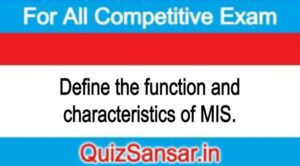
Define the function and characteristics of MIS.
Define the function and characteristics of MIS.
Ans.
Management information system is a set of systems which helps management at different levels to take better decisions by providing the necessary information to managers. Management information system is not a monolithic entity but a collection of systems which provide the user with a monolithic feel as far as information delivery, transmission and storage is concerned.
Managers are the key people in an organization who ultimately determine the destiny of the organization. They set the agenda and goals of the organization, plan for achieving the goals, implement those plans and monitor the situation regularly to ensure that deviations from the laid down plan is controlled. This set of activity ensures the smooth functioning of the organization and helps it attain its objectives. Hence, these managers are vital for a successful organization. The managers in turn conduct these activities collectively management functions. They decide on all such issues that have relevance to the goals and objectives of the organization. The decisions range from routine decisions taken regularly to strategic decisions, which are sometimes taken once in the lifetime of an organization. The decisions differ in the following degrees:
1. Complexity
2. Information requirement for taking the decision
3. Relevance
4. Effect on the organization
5. Degree of structured behavior of the decision-making process.
The different types of decisions require different type of information as without information one cannot decide.
They have common characteristics and even though their actual implementation in an organization may differ according to the needs of the organization, their basic characteristics remain the same. The information technology platform on which management information system is based may also vary in terms of complexity and scale but the technology component does not change the broad characteristics of management information system. Technology is only the medium through which the solution is delivered. Management information systems may consist of a set of information systems working towards the common goal of achieving greater efficiency in management decision-making for each level of management. Typically, management information systems deal with information that is generated internally. The in-house data is processed (summarized/ aggregated) to create reports, which helps the management at different levels in taking decisions, Today’s management information systems have a data repository at the core, which is mostly in the form of a relational database management system. All in-house data (mostly transaction related) are saved in this database, which is itself designed on the basis of set rules. Over this data repository lies several tiers of logic and/or business rules which helps in creating an interface and the various reports for use of managers at different levels. The management information system is normally designed in order to achieve an information flow that is based on a ‘need to know’ principle. This means that any manager would be given only that type and kind of information for which he is entitled and for which he has any use. This means, that a shop floor supervisor may get the personal details of all people working under him but will not get to view the salary details of the CEO as he/she is not entitled to know such information. The floor supervisor will not get to see the personnel details of all employees working in the human resource department as he has no use for such information. This hierarchical rule-based information delivery to the different levels of management is put in place to avoid both information overload and to enable information security.
Many modern systems have come up in recent times to help the manager in their tasks, like enterprise-wide resource planning systems that is, basically, transaction processing/ support systems but comes inbuilt with a lot of best practices of the industry and helps in generating integrated scenarios for the managers at different levels. Customer relationship management systems help in the management of customers by creating profiles and making available complex analytical tools for processing customer data to the managers. Similarly, there are systems to help managers deal with supply chain data called supply chain management systems. All these modern systems help in achieving greater efficiency by making the job of management decision-making better and therefore, fall under the category of management information system.






